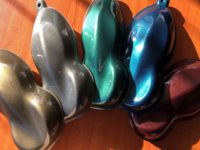Amines That Best Neutralize Acid
In a waterborne alkyd coating, what amines will work to neutralize the acid?
Typically ammonia is used due to the cost, but other amines will work well, including triethyl amine. Amines that are high boiling-above the boiling point of water-should be avoided because they will remain in the film after the water leaves and may result in lower film strength due to lower chain entanglement. This problem is greater for acrylic waterborne coatings but is generally not a major problem for alkyds because their molecular weight is usually low and it crosslinks through air oxidation.
Solvent's Effect on Pot Life
What effect does the choice of solvent have on the pot life of waterborne epoxy coatings?An amine emulsifier typically forms waterborne epoxy coatings. Usually the amine hardener acts as the surfactant through salt formation with added acetic acid. The epoxy is added to this emulsion and is soluble within the micelle. Once mixed, the amine begins to react with the epoxy and, usually within 30 minutes, the liquid micelle becomes a hard particle.
One method to extend the pot life is to add a coalescent aid such as ethylene glycol mono-butyl ether, EB. When the water leaves, the coalescing solvent plasticizes the resin enough to allow film formation, even though the polymer has partially polymerized. However, this approach usually only extends the pot life to about 90 minutes for a coating with 1.5 pounds of VOCs per gallon. The problem is that the resin continues to polymerize within the micelle and becomes insoluble and crosslinked as a particle.
To retard the reaction, a solvent, which is hydrophobic, must be used. Often xylene or cumene is used, which will enter the micelle and dilute the reactants. This decreases their reaction rate and extends the pot life to about eight hours for a coating with 1.5 pounds of VOCs per gallon.
Ketones and esters, as well as ethers, can be used, provided they are hydrophobic enough. Care must be used with esters to avoid hydrolysis of the ester, and amines may react with some ketones in undesirable ways. Solvents with intermediate characteristics, such as benzyl alcohol, will modify the pot life in a way that is between the two extremes. It is best to use a solvent that dilutes the reactants in the micelle and acts as a coalescent aid to increase the pot life to the maximum per pound of VOCs.
Measuring Temperature While Coating Dries
How can the temperature of a solventborne coating be measured while it dries?The temperature profile of a coating during drying is a critical aspect of many OEM coating systems. As the solvent evaporates, it removes heat due to the heat of vaporization of the solvent. This heat loss results in the surface temperature falling. If the temperature drops significantly, it reduces the evaporation rate. If the temperature falls below the dew point, then water will condense on the surface, which can cause many paint failure modes.
Since heat is replaced both from the front and the back in metals and mainly from the front in wood and plastics, you cannot simply put a thermocouple on the surface. A better method is to use an infrared thermometer. This method utilizes emitted infrared radiation coming from the coating. It may have the drawback of being less accurate in absolute temperature, but it does not interfere with the normal drying processes because it has a stand-off distance of about 40 mm.
Hide Differences Between Organic, Inorganic Pigments
Why do organic pigments usually have less hide than inorganic pigments?Organic pigments often have refractive index values near that of the resin, usually between 1.4 and 1.7. Most extender pigments also have refractive index values in this range, and they also do not result in hide. Organic pigments produce hide primarily by absorption of the light, both on the way in and the way back out of the film. Organic pigments usually have high extinction coefficients and thus are excellent colorants.
In the case of many inorganic pigments that do produce significantly better hide, the refractive index is much higher. For example, the refractive index of red iron oxide is 2.4 to 3.0, zinc oxide is 2.02, and rutile titanium dioxide is 2.73. In general, the higher the refractive index, the better the hide due to scattering of light.



